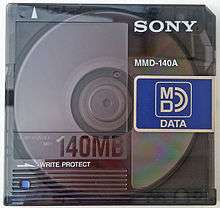MD Data

MD Data stands for MiniDisc-Data, and is a magneto-optical medium for storing computer data. Sony wanted MD Data to replace floppy disks, but the Zip drive from Iomega ended up filling that market need and, later on, the advent of affordable CD-writers and very cheap blank CD media, coupled with the availability of memory sticks and cards proved the final straw for MD-Data.
The technology provided 140 MB of data storage, but it was slow and expensive. Also, data drives can only read or write audio MDs when set in "play" mode, which, however, does not provide computer access to the data.
MD Data appeared in products such as an MD still camera and an MD document scanner. MD Data was also used in the late 1990s in 4- and 8-track multitrack recording decks. Meant as a step up from the popular 4-track cassette-based studios, these recorders enjoyed a brief prominence before they were replaced by relatively affordable -- and far more flexible -- direct-to-hard drive recording on Windows and Macintosh based computers. The format has always been hampered by the lack of an affordable MD-Data drive with which to manipulate and back up data using a PC.
In 1997, Sony introduced the MD-Data2 format, which could hold 650 MB of data (as opposed to MD-Data's 140 MB). However this format was only used by Sony's DCM-M1 camcorder (capable of still images and MPEG-2 video), and a few multitrack "portastudio"-style audio recorders such as Sony's MDM-X4 and Tascam's 564, among others.
The introduction of Hi-MD in 2004 allowed any type of data (files, music, etc.) to be stored on a Hi-MD formatted MiniDisc. This allows for storage capacity of around 340MB on a standard MiniDisc and approx. 1GB on a new, higher-density Hi-MD.